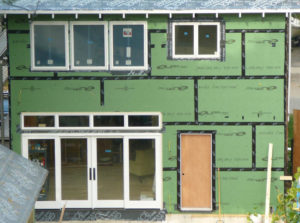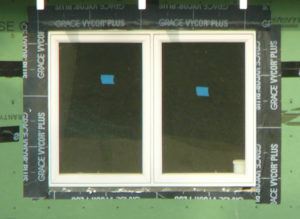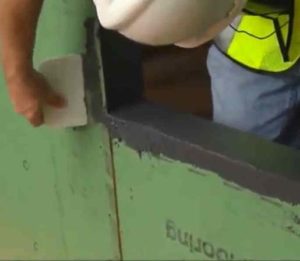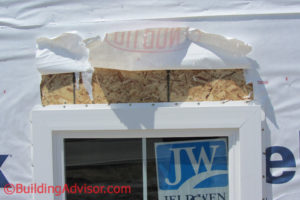Q: How does the ZIP system compare to standard sheathing? It seems like 9 out of 10 new homes and remodels in my area (northern New England) are using green ZIP sheathing on the walls and some use the red version of the roof as well. How does this product compare to using plywood and a housewrap such as Tyvek? — Tom
A: Zip System sheathing was introduced by Huber Engineered Woods in 2008 and it has been widely adopted in many parts of the US. Huber manufactures the premium OSB products such as Advantech sheathing, which many builders prefer over plywood, due in part to quality problems they were seeing in plywood.

The chief virtue of Zip System sheathing is that it marries the water-resistant barrier (WRB) to the sheathing, eliminating the step of adding a separate layer of asphalt felt, Tyvek, or any of the many house wrap products on the market.
A lot of builders like the Zip system a lot because it eliminates what has always been a troublesome step in the building process. That is, carefully installing large sheets of plastic around the entire house, carefully lapping it at seams, and more carefully cutting and taping it around windows and doors so it directed any water to the exterior.
While Tyvek, the first popular house wrap, was originally marketed as an energy-saving material, it was soon disproven that a house with Tyvek, installed typically, wasn’t much tighter than a conventional home with asphalt felt.
A house built with Zip sheathing, however, taped and sealed as recommended, produces a very tight house without a lot of fussing. This is especially true in relatively simple building plans without a lot of bumps, angles, and complex shapes.

The main downside of Zip Sheathing is the heavy reliance on flashing tape. Huber makes the high-quality tape in various widths and also makes a stretch version for window pan flashing and other tricky details. Still, water, frost, or dirt can undermine a watertight seal, as can sloppy installation.
Liquid-applied sealants offer an alternative to tape that is gaining in popularity. One example is Huber’s Liquid Flash, a thick liquid flashing that is applied with a caulking gun and spread with a trowel. Liquid flashing provides a a nearly foolproof solution for waterproofing window pans, foundation joints, and other tricky or vulnerable transitions.

Like any product or system Zip sheathing has pros and cons. Some are actual and proven, some more theoretical. The product has not really been around long enough to stand the test of time. But, there are few reports of failures in the field and most contractors who have tried the system are happy with it overall.
Here are the main arguments, pro and con:
Pros
- Installs the sheathing and water-resistant barrier in one step. Saves labor.
- Makes it relatively easy to create a very tight shell.
- This is a complete system with high quality tapes and liquid sealant, as well as published details backed by a reputable company.
- Backed by a 30 year warranty, but not transferable, and subject to the usual conditions about proper installation.
- Window installation and flashing is easier than with housewrap (but relies on tape at the window head flashing). Origami style folding of the housewrap is eliminated.
- Quick dry-in for the contractor with less concern about wind and water.
Cons
- Tape must be installed carefully without dirt, frost, or moisture to seal well.
- Horizontal seams are vulnerable to water penetration if the tape fails. This is especially a concern at the tops of doors and windows.
- Less permeable to moisture than most house wraps, so in theory the wall may not dry our as easily.
- Not a true drainage plane, which can be created with draining house wraps. Vertical spacers or a second layer of housewrap would be needed for a true drainage plane.
- If nails are overdriven, especially “shiners” that miss the framing, the OSB is exposed and needs sealing with tape or sealant.
- More expensive materials (but savings on labor).
- On a roof, especially, I would be reluctant to trust the tape to prevent leaks, so would want another layer of roofing felt or synthetic underlayment.
Bottom Line
Many builders like the simplicity of the Zip system. To a large extent, its long-term performance depends on the durability of the taped seams. If applied to a clean surface with a roller, as recommended, all indications are that it will provide a long service life. This is a high-performance tape. Still, it is partly a matter of faith that it will remain water tight for decades.

On the other hand, house wrap does not last forever either. It tends to get brittle and deteriorate over time. It can deteriorate rapidly if it stays wet due to trapped water — for example, if a section of house wrap gets bunched up behind a piece of trim as I have seen around windows, corner boards and other exterior trim.
With any waterproofing product, the quality of the workmanship is at least as important as the material. A house built well with wood sheathing covered with asphalt paper or plastic house wrap can perform as well as one with Zip sheathing. It just a matter of careful detailing — especially around doors, windows, and other joints prone to leakage.
You can find a complete library of technical documents for the Zip System at this link. — Steve Bliss, BuildingAdvisor.com
em says
Not a fan of OSB for exterior walls. cdx plywood and tyvek.
Selena says
Also consider that ZIP is a Structural 1 panel which is far stronger than a commodity OSB or plywood panel. There’s more to it than just the fused on WRB. Additionaly, the drainage is greater than 90% due to the texture of the panel.
Stephen Whalen says
Follow up question. Why is the roof Zip System brown?
Selena says
Green Zip panels are 7/16. Brown are 1/2 or 5/8.
Also consider that ZIP is a Structural 1 panel which is far stronger than a commodity OSB or plywood panel. There’s more to it than just the fused on WRB. Additionally, the drainage is greater than 90% due to the texture of the panel.
Christopher Ayarza says
Use Zip Tape, but Not Sheathing
I use the Zip tape to seal around windows but I’m reluctant to use any osb for exterior sheathing. I prefer cdx plywood , house wrap (felt or Tyvek), then use Zip tape around all door and window flanges. For certain their tape is superior to any other similar products.
Dave Sloneker says
Prefer Plywood With Felt Paper
Experience has taught me that a quality sub panel,3/4 cdx plywood with a coat of acrylic primer (sealer) allied after installation then 30# felt is much better than any of this newer product out there.This technology has been around for for a long time and PROVEN.The real issue is in the installation by poorly trained installers who have speed vs. quality in mind. There are many good new ideas out there but the cons for this zip system are,and will be proven over time.Just one major one is lack of protection from dust and fumes when cutting this product with saw or router.The dust is harmful in a solid state when breathed in.I roll the sealer on after cutting out all openings,then use the liquid flash at the Windows and doors paying special interest to the floor at the door area.AGAIN most trouble is in the execution of installation.
Sam Watson says
Impressed With Zip System
I used the Zip System to replace 100-year-old, dried, rotten, and super heated sheathing boards on our 8/12 pitch farm house. Due to extenuating circumstances, we relied on the brown Zip and properly installed and rolled Zip tape through the entire winter and first half of the following summer. Well beyond the recommended exposure time, with zero issues. We actually tried pulling off a piece of Zip tape after 10 months and it is nearly impossible. Incredibly impressive product. The only vulnerability we found is not following directions. And with any newer, tighter building techniques, the homeowner needs to manage their moisture in their homes. Good adequate bath fans, kitchen fans, we will also be installing laundry exhaust fans. Our roof is a vented assembly also. Good work Huber!